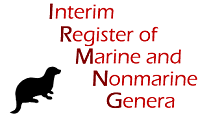
| Intro | | Search taxa | | Taxon tree | | Search literature | | Taxon match | | Homonyms | | Statistics | | Webservice | | Manual | | FAQ | | LifeWatch | | Download | | Log in |
IRMNG name detailsPseudocucumaria Katto, 1974 †
marine,
fossil only
Not documented
Taxonomic remark From Knaust, 2020: This structure contains sediment pads mimicking a spiral-like development and thus was compared with...
Taxonomic remark From Knaust, 2020: This structure contains sediment pads mimicking a spiral-like development and thus was compared with (and named after) the spiral faecal strings of the holothurian Cucumaria. However, Pseudocucumaria instead represents an actively filled burrow such as Parataenidium (Buatois et al. 2017), pending its detailed examination. [details]
IRMNG (2021). Pseudocucumaria Katto, 1974 †. Accessed at: https://www.irmng.org/aphia.php?p=taxdetails&id=11915773 on 2025-04-02
Date action by
basis of record
Knaust, D. (2020). Invertebrate coprolites and cololites revised. <em>Papers in Palaeontology.</em> 2020: 1-39., available online at https://doi.org/10.1002/spp2.1297 [details]
status source Knaust, D. (2020). Invertebrate coprolites and cololites revised. <em>Papers in Palaeontology.</em> 2020: 1-39., available online at https://doi.org/10.1002/spp2.1297 [details] verified source for family Knaust, D. (2020). Invertebrate coprolites and cololites revised. <em>Papers in Palaeontology.</em> 2020: 1-39., available online at https://doi.org/10.1002/spp2.1297 [details] name verified source Knaust, D. (2020). Invertebrate coprolites and cololites revised. <em>Papers in Palaeontology.</em> 2020: 1-39., available online at https://doi.org/10.1002/spp2.1297 [details] extant flag source Knaust, D. (2020). Invertebrate coprolites and cololites revised. <em>Papers in Palaeontology.</em> 2020: 1-39., available online at https://doi.org/10.1002/spp2.1297 [details] habitat flag source Knaust, D. (2020). Invertebrate coprolites and cololites revised. <em>Papers in Palaeontology.</em> 2020: 1-39., available online at https://doi.org/10.1002/spp2.1297 [details] Unreviewed
Taxonomic remark From Knaust, 2020: This structure contains sediment pads mimicking a spiral-like development and thus was compared with (and named after) the spiral faecal strings of the holothurian Cucumaria. However, Pseudocucumaria instead represents an actively filled burrow such as Parataenidium (Buatois et al. 2017), pending its detailed examination. [details]
|